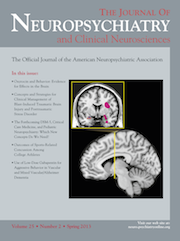A Kind of D-Amino Acid Oxidase Inhibitor, Sodium Benzoate, Might Relieve Panic Symptoms in a First-Episode, Drug-Naïve Panic-Disorder Patient
To the Editor: It is unusual to discuss a glutamate-related mechanism in the treatment of panic disorder (PD). Here, I want to share a case of PD, who had significant improvement of panic symptoms within 6 weeks after receiving a kind of D-amino acid (DAA) oxidase inhibitor, sodium benzoate (SB).
Case Report
“Mrs. L” is a 58-year-old, female, first-episode, drug-naïve PD patient with the following panic symptoms for 6 months: unexplained abdominal pain, gastrointestinal upset, dyspepsia, chest tightness, palpitations, dizziness, and limb numbness. These symptoms occurred suddenly and exacerbated progressively within 10 minutes. She had significant anticipatory worry about additional attacks, and these attacks had already caused significant disturbances of her social and occupational role. She received many kinds of physical or laboratory examinations, such as electrocardiogram, chest X-ray, computed tomography of chest, and magnetic resonance imaging of brain and spine, but all these examinations failed to find any medical reason for these somatic symptoms. She also refused to take antidepressant or benzodiazepine treatment for fear of side effects and only received nonpharmacologic treatment. After signing informed consent, she started to take sodium benzoate (SB) for her panic symptoms. No concurrent psychotherapies were performed in this patient during SB treatment. After 2 weeks of SB, she had mild improvement of PD (PDSS score: 18 → 13), with less severity of abdominal discomforts, chest tightness, palpitations, and anticipatory anxiety. However, during the first 2 weeks, she still had limb numbness, dizziness, and headache. At the 6th week, she experienced subsequent response in PD symptoms (PDSS score: 13 → 7). She also had less dizziness, less anticipatory anxiety, and more improvement in abdominal discomfort, chest tightness, and palpitations. Residual PD symptoms, such as limb numbness and headache, were still noted in the 6th week. No significant side effects of SB treatment during this 6-week period were mentioned.
Discussion
Several antidepressants have been reported to act via glutamate receptors, and glutamate is a target for the development of novel antidepressants.1 Glutamate receptor-related agents also can relieve symptoms of posttraumatic stress disorder, one kind of anxiety disorder.2 In this case, she received SB, which increases the level of DAA because of inhibition of DAA oxidase. DAA genotype has been reported to be associated with anxiety.3 D-serine, one kind of DAA, can enhance fear extinction through glutamate receptor-induced phosphorylation signaling in hippocampus and amygdala. It also suggests DAA’s potential role in the treatment of anxiety disorders.4
A pilot study of D-serine in the treatment of posttraumatic stress disorder also suggests that D-serine can reduce anxiety through its glutamate receptor glycine-based mechanism.5 DAA also can enhance adaptive learning to changing environments, extinguish contextual fear memory, and improve cognitive flexibility and inhibitory learning in the face of significant stress. These DAA-related actions might provide a role for DAA in treating anxiety disorders.6 Hofmann et al. found that D-cycloserine, another kind of DAA, reduces social distress and anxiety in social-phobia patients.7 Another randomized, controlled trial of D-cycloserine with exposure therapy also replicates their findings.8 Behavioral therapy augmentation with D-cycloserine or sarcosine (with similar mechanism to D-cycloserine) can also reduce anxiety symptoms of obsessive-compulsive disorder patients.9,10 To my knowledge, this is the first case of clinical response to SB treatment in PD. Further well-controlled study will be needed to clarify SB’s role in PD therapy.11–14
1 : Glutamate and GABA systems as targets for novel antidepressant and mood-stabilizing treatments. Mol Psychiatry 2002; 7(Suppl 1):S71–S80Crossref, Medline, Google Scholar
2 . Glutamate as a therapeutic target in psychiatric disorders. Mol Psychiatry 2004;9:984-997, 979Google Scholar
3 : Dysbindin and d-amino-acid-oxidase gene polymorphisms associated with positive and negative symptoms in schizophrenia. Neuropsychobiology 2009; 60:31–36Crossref, Medline, Google Scholar
4 : D-serine enhances extinction of auditory cued fear conditioning via ERK1/2 phosphorylation in mice. Prog Neuropsychopharmacol Biol Psychiatry 2010; 34:895–902Crossref, Medline, Google Scholar
5 : Pilot controlled trial of D-serine for the treatment of post-traumatic stress disorder. Int J Neuropsychopharmacol 2009; 12:1275–1282Crossref, Medline, Google Scholar
6 : Genetic inactivation of D-amino acid oxidase enhances extinction and reversal learning in mice. Learn Mem 2009; 16:28–37Crossref, Medline, Google Scholar
7 : Augmentation of exposure therapy with D-cycloserine for social anxiety disorder. Arch Gen Psychiatry 2006; 63:298–304Crossref, Medline, Google Scholar
8 : A randomized, controlled trial of D-cycloserine enhancement of exposure therapy for social anxiety disorder. Biol Psychiatry 2008; 63:544–549Crossref, Medline, Google Scholar
9 : Augmentation of behavior therapy with D-cycloserine for obsessive-compulsive disorder. Am J Psychiatry 2008; 165:335–341, quiz 409Crossref, Medline, Google Scholar
10 : Sarcosine therapy for obsessive compulsive disorder: a prospective, open-label study. J Clin Psychopharmacol 2011; 31:369–374Crossref, Medline, Google Scholar
11 : D-cycloserine does not improve but might slightly speed up the outcome of in-vivo exposure therapy in patients with severe agoraphobia and panic disorder in a randomized, double-blind clinical trial. J Psychiatr Res 2011; 45:1042–1047Crossref, Medline, Google Scholar
12 : Determination of sodium benzoate by chiral ligand exchange CE based on its inhibitory activity in D-amino acid oxidase mediated oxidation of D-serine. Anal Chim Acta 2011; 691:103–109Crossref, Medline, Google Scholar
13 : The N-methyl-D-aspartate receptor co-agonist D-cycloserine facilitates declarative learning and hippocampal activity in humans. Biol Psychiatry 2010; 67:1205–1211Crossref, Medline, Google Scholar
14 : A series of D-amino acid oxidase inhibitors specifically prevents and reverses formalin-induced tonic pain in rats. J Pharmacol Exp Ther 2011; 336:282–293Crossref, Medline, Google Scholar



